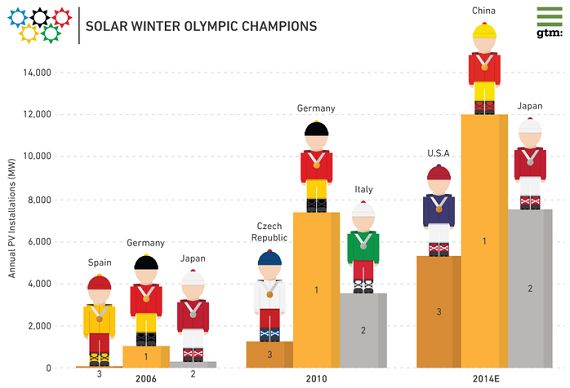With the Winter Olympics kicking into high gear in Sochi this week, GTM Research wanted to take a look at past Winter Olympics to see which countries ended up on the solar PV podium. We also used data from our global solar practice to make some predictions for this year's solar Olympics.
Torino 2006
Not only did Germany take home the most gold medals in the 2006 Winter Olympics, but it also installed the most solar. The country installed over 1,000 megawatts in 2006, a huge milestone at the time, and took home the solar gold. Japan wore silver around its neck with 286 megawatts installed, and Spain joined them on the podium with 88 megawatts.
Vancouver 2010
After four years of rigorous training, falling module prices and increased incentives, global solar competition stiffened. Germany proved again to be world solar champion, crushing its 2006 numbers with 7,378 megawatts of PV installed. (The International Olympic Committee still has not released a report on Germany's installer doping controversy.) Italy, away from its home turf in Torino, earned the silver in 2010, installing over 3,500 megawatts. The Czech Republic took home the bronze with a respectable 1,264 megawatts -- a giant feat for a small country.
Sochi 2014
So what’s in store for Sochi this year? GTM Research expects 2014 to be the year when Germany is knocked off the podium entirely. According to our U.S. Solar Market Insight report, the United States, led by notable Olympian California, will finally earn itself a bronze medal, installing over 5,300 megawatts over the course of the year. Japan will earn its second silver medal in three tries with 7,500 megawatts installed. But the victor will be a new face in the solar Winter Olympic standings: China. The country is forecasted to install 12,000 megawatts of PV in 2014 alone -- more than the United States has installed in all of its solar history.
"China's rise to the top in global PV installations has been impressive, to say the least," said GTM Research solar analyst Adam James. "Although transparency continues to be a problem in accurately sizing the market, GTM sees the shift to production-based incentives and increased downstream financing support driving deployment to new heights over the next few years."
"While European feed-in tariff markets have been great at the short-distance events, the global solar market is clearly aiming toward the long-distance contenders in Asia and North America," said Shayle Kann, senior vice president at GTM Research. "But don't count out emerging markets. By the time the Summer Olympics roll around in Rio, Latin America will be a PV force to contend with."
***
Sick of winter? Join us in sunny Arizona for this year's Solar Summit in April. Save $400 if you register on or before 3/17.




